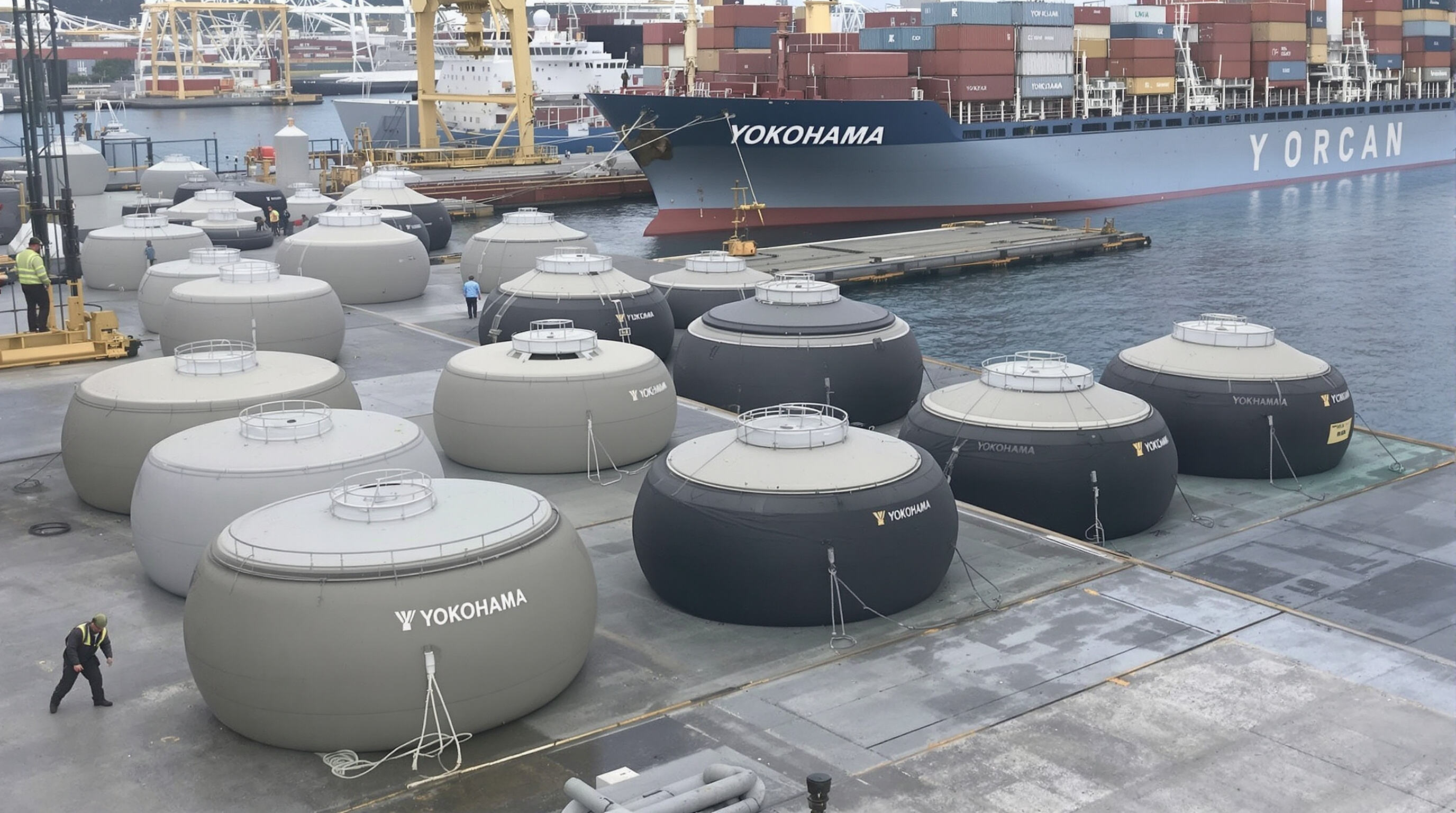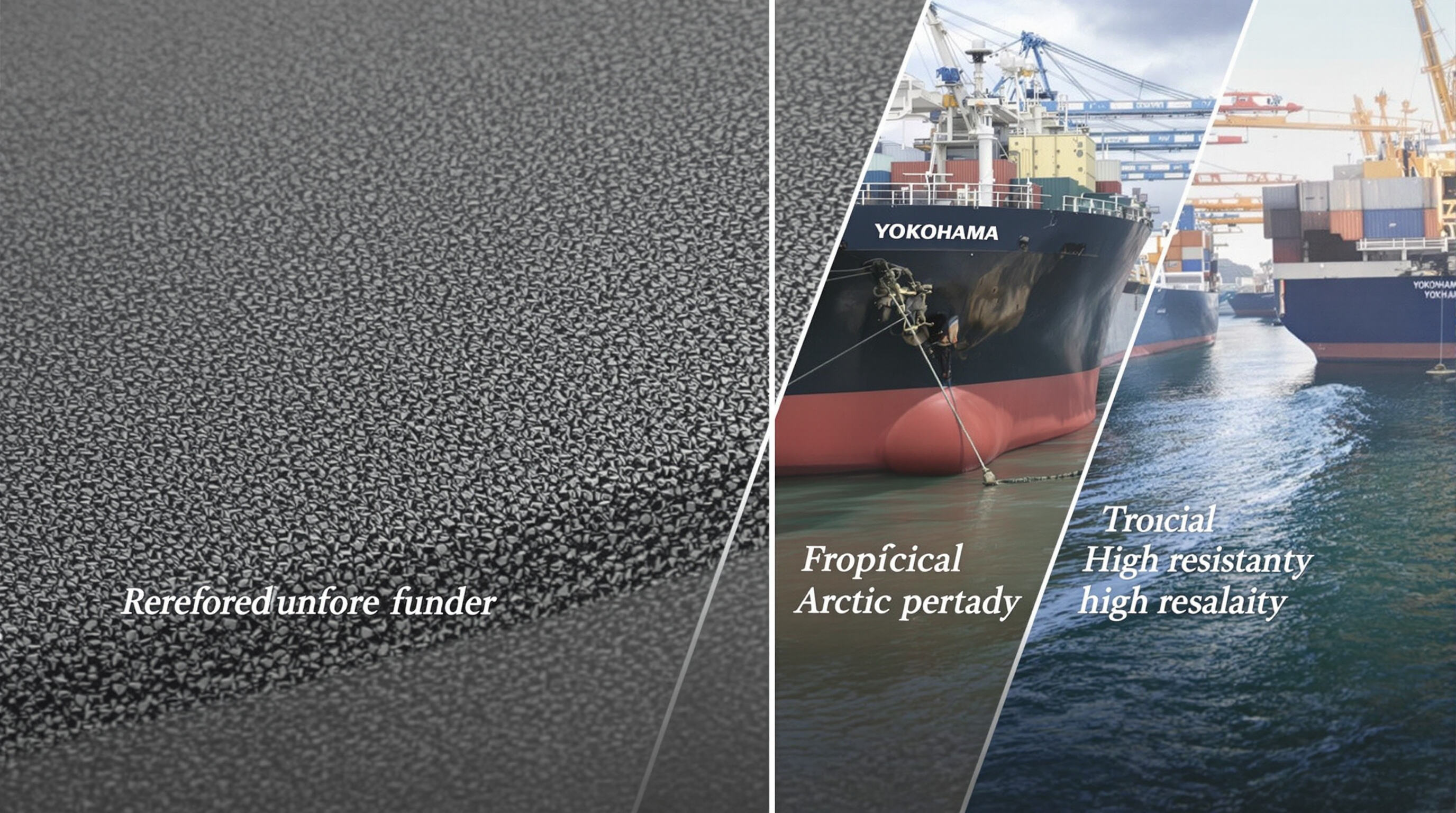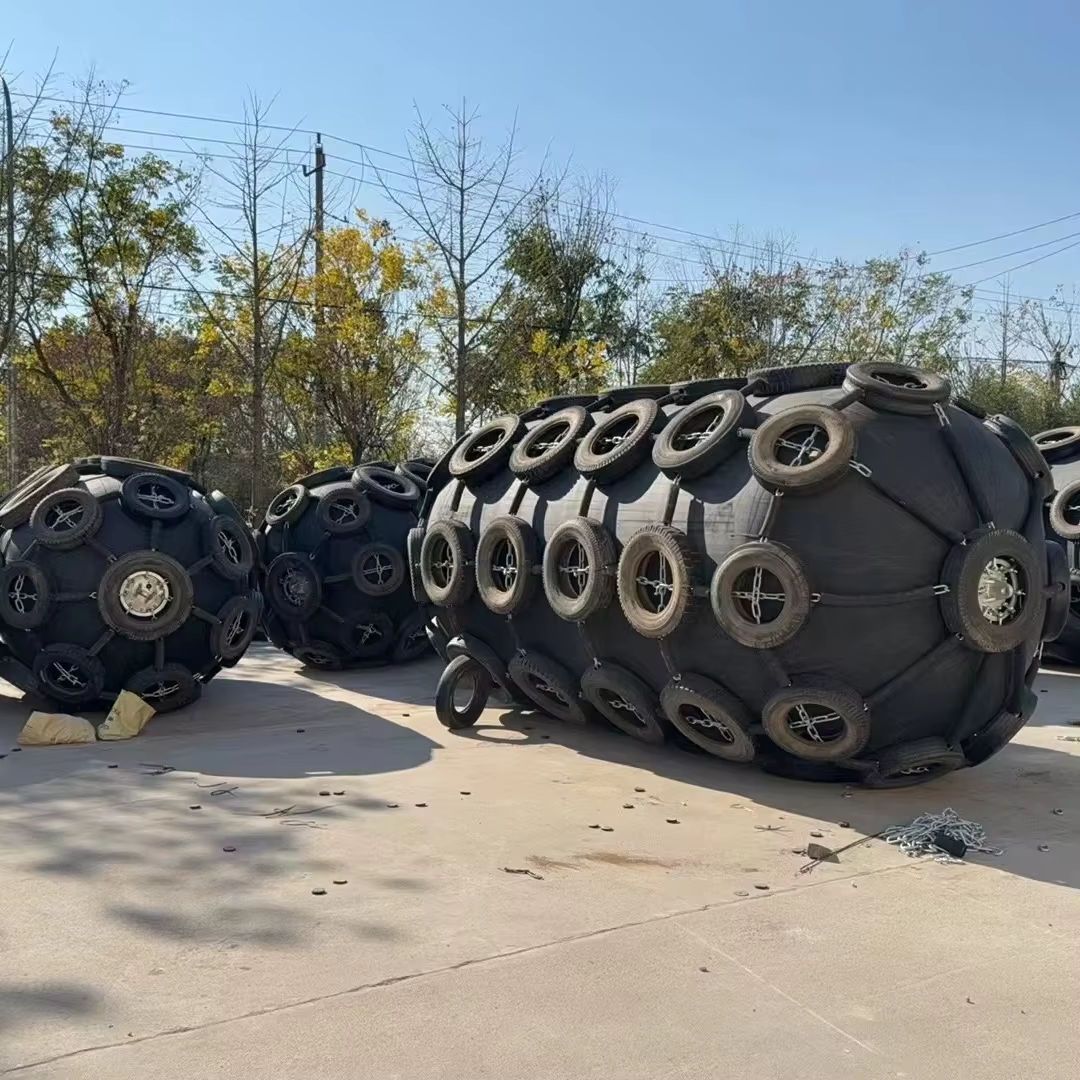Understanding Yokohama Fenders and Their Role in Marine Safety
Yokohama fenders are high-performance pneumatic systems engineered to absorb kinetic energy during vessel berthing, safeguarding both ships and port infrastructure. Originally developed from early marine bumpers, modern versions use reinforced rubber with synthetic cord layers for superior strength and resilience.
What Are Yokohama Fenders and How Do They Support Marine Safety?
Yokohama fenders act as important shock absorbers when ships dock at harbors, cutting down on accidents during the mooring process. Made with elastic materials, they compress when hit, which helps spread out the force so it doesn't wreck boat hulls or damage the dock itself. Ports with lots of ship traffic especially benefit from this since fewer collisions mean less money spent on fixes and safer working conditions for everyone involved. These rubber buffers have become standard equipment across many commercial harbors around the world because they just work so well at keeping things running smoothly day after day.
The Evolution of Pneumatic Fenders in Maritime Operations
In the 1970s, pneumatic fenders started taking over from those old rigid foam and wooden alternatives because they could adjust pressure settings and worked better when tides changed. These days, ports actually use these fenders for all sorts of ships, from small 500 GT barges right up to massive 200,000 DWT tankers that can be quite a challenge to handle properly. The materials have come a long way too. With things like UV stabilized rubber compounds now being used, these fenders last anywhere between 15 to 25 years even in really tough saltwater conditions. That kind of longevity makes them pretty much standard equipment at most modern harbors where reliability is absolutely essential.
Key Applications of Yokohama Fenders Across Berthing Environments
These fenders are particularly effective in three main scenarios:
- Tidal ports, where buoyancy compensates for fluctuating water levels
- High-energy berthing zones, absorbing up to 3,000 kJ during LNG carrier docking
- Confined shipyards, providing compact protection during construction or repair
Their modular design enables retrofitting on steel-pile docks and concrete quay walls, supporting upgrades to aging port infrastructure without major structural changes.
Matching Yokohama Fender Types to Vessel Size, Type, and Berthing Energy

How Vessel Size, Displacement, and Draft Influence Yokohama Fender Selection
When bigger ships come into port, they bring way more kinetic energy with them, which means the fenders need to handle much more pressure. The weight of the ship (what we call displacement) basically tells us how much energy needs to be absorbed during docking. Then there's the draft of the ship, which affects where exactly those protective fenders should go along the side of the hull. Take a Panamax class ship for instance these things usually weigh around 65 thousand deadweight tons on average. For such massive vessels, harbor authorities generally install fenders that are somewhere between 1.5 and 2.5 meters across. This size range works well for controlling the speed at which these big ships approach the dock, typically keeping berthing speeds below about 0.15 meters per second.
Energy Absorption Requirements for Tankers, Container Ships, and Specialized Vessels
Tankers and LNG carriers demand high energy absorption–ranging from 500 to 2,500 kNm–due to their massive displacements (100,000–250,000 DWT). Container ships require rapid energy dissipation due to faster berthing speeds (0.2–0.3 m/s), while RO-RO vessels benefit from low-reaction fenders that balance 30–40% compression with 200–400 kNm absorption to avoid hull damage.
Calculating Berthing Energy and Reaction Force Using ISO and PIANC Guidelines
Berthing energy is calculated using the ISO 17357 formula:
The energy absorption calculation looks something like this: E equals half times velocity squared multiplied by displacement, then multiplied again by both the virtual mass coefficient (usually between 1.5 and 2.0) and the eccentricity factor. According to guidelines from PIANC Working Group 33, it's generally wise to keep those reaction forces under about 80 to 100 kilonewtons per square meter when dealing with concrete dock structures, otherwise there might be some serious structural issues down the road. Most engineers follow these recommendations closely when picking out Yokohama fender systems. They need to find ones that match the required performance specs, like those 2 meter diameter models that can soak up around 800 kilonewton meters of energy at approximately 55 percent compression level. Of course, actual selection depends on site specific conditions too.
Evaluating Docking Conditions and Berth Configuration for Optimal Performance
Impact of Berth Layout, Tidal Variations, and Wave Action on Fender Effectiveness
Yokohama fenders need to work well across all sorts of situations, from how the berths are shaped to changes in tides and waves hitting them. For those open berths where the water moves around a lot, we often find that the fenders need about 15 to maybe even 20 percent more energy absorption compared to what's needed at protected terminals. Why? Because there's just more sideways force acting on them. When tides go up and down by more than three meters, this changes how the fender makes contact, so we need designs that can handle a wide range of movement. Looking at pneumatic options, these tend to hold up pretty well, maintaining roughly 92% of their original strength even after going through 100 thousand compression cycles. That kind of durability gives them an edge over rigid systems when dealing with constantly changing conditions at sea.
Fixed vs. Floating Docks: Compatibility and Performance With Yokohama Fenders
When dealing with fixed concrete piers, we need fenders that can handle vertical movement from tides ranging around half a meter to over one meter without messing up how forces get distributed across the structure. Floating docks are different because they rise and fall with water levels naturally, but this creates all sorts of unpredictable compression issues that call for special fenders able to respond to changing pressures. According to some hydrodynamic studies, those round air-filled cylinders actually cut down on peak mooring line stress by about a third when compared to traditional arch fenders used on floating platforms. This makes them particularly useful for those smaller draft roll-on/roll-off ships that operate in shallower waters where every bit of stability counts.
Mooring Dynamics and Environmental Loads in Challenging Port Environments
When dealing with those massive container ships carrying over 18,000 TEUs, the fenders at Yokohama port face serious challenges from multiple directions. They have to hold up against winds blowing at 25 meters per second, sideways currents moving at three knots, plus the powerful thrust from ship propellers. The latest rubber composite materials are making waves in the industry though, lasting around four decades even in brutal Arctic temperatures down to minus 30 degrees Celsius. Cold weather used to be a real problem for these materials, causing them to wear out much faster. For LNG terminals located in earthquake-prone areas, there's another layer of complexity. Specialized fender systems there manage to soak up about 85% of the impact energy right from the start, during just half of their maximum possible compression. This performance standard has been proven through rigorous real-world tests following the ISO 17357 shock testing protocol.
Material Durability and Long-Term Performance of Yokohama Pneumatic Fenders

Yokohama's modern fenders meet important industry standards including ISO 17357-1 and PIANC WG33. The rubber compounds used maintain around 92% of their original elasticity even after spending 10,000 hours under UV light. These materials also offer Class 3 protection against ozone damage, something really important for equipment operating near saltwater areas. Tests show that cracks don't spread easily through these materials, so they last much longer when exposed to harsh conditions. This matters a lot in places like Singapore where container ships constantly bump into dock structures, creating constant wear and tear on maritime infrastructure.
Service life and maintenance: Real-world performance across port types
Field data from 142 global port operators reveals consistent longevity and manageable maintenance requirements:
| Environment | Avg. Service Life | Maintenance Frequency |
|---|---|---|
| Tropical harbors | 12-15 years | Annual pressure checks + bi-annual cleaning |
| Arctic terminals | 8-10 years | Quarterly ice-impact inspections |
| High-salinity docks | 10-12 years | Semi-annual ozone resistance tests |
Replacing protective chain nets every 3–4 years reduces surface wear by 40%, significantly extending overall system life.
When it comes to upgrading old berthing structures, many ports are turning to durable Yokohama fender systems for their retrofit projects. These modular setups work pretty well with most existing concrete pile docks actually around 93 percent of them thanks to standard mounting hardware that makes installation straightforward. Take Rotterdam's older oil terminals for instance. After installing these Yokohama fenders, they saw impact forces drop by roughly 30 something percent without having to change any of the original structure. What really stands out though is how these systems handle different tides. The adaptive pressure chambers keep performing at their best even when water levels fluctuate up or down by about two meters. This means ships get protected consistently whether the tide is high or low, which matters a lot for safety and maintenance costs over time.
Future Trends in Yokohama Fender Technology and Smart Berthing Integration
Smart Sensors and Real-Time Pressure Monitoring in Next-Gen Fenders
The latest Yokohama fenders now come equipped with IoT sensors that keep track of pressure levels, how stress spreads across the structure, and any deformations happening as they happen. These sensor systems give port managers actual data they can work with, so they spot when cargo is loaded unevenly and plan maintenance before problems arise. Some tests from last year showed that ports using these smart fenders cut down on unexpected stoppages by around 35 to 40% because issues get caught early. What's really handy is that the built-in sensors will automatically adjust mooring lines when there are big tides coming in or if ships start moving around unexpectedly, which helps prevent those costly collisions we all want to avoid.
AI-Driven Simulation and Predictive Modeling for Optimal Fender Selection
These days, machine learning systems look at past berthing records, ship characteristics, and environmental factors when suggesting the best fender configurations. When combining standards like ISO 17357 and PIANC WG33 with actual field conditions, artificial intelligence cuts down on unnecessary design elements by around 25%, according to research from Japan's Fender Association back in 2023. The digital twin technology simulates how different situations might play out - think massive container vessels navigating crowded ports versus liquefied natural gas tankers squeezing into narrow berths. This helps create specs that work well for what actually happens in practice rather than just theoretical ideals.
Sustainable Materials and Circular Design in Modern Inflatable Marine Fenders
Major industry players have started incorporating bio-based rubber blends along with closed loop recycling methods as part of their sustainability efforts. Recent tests indicate that materials without chloroprene still manage to absorb around 97% of what traditional fenders do, but they cut down on factory emissions by roughly 42 percent according to MarineLog from last year. When it comes to modular designs, replacing just worn out parts instead of whole systems means these structures can last anywhere between 15 to 20 extra years. This approach definitely supports those circular economy ideas we keep hearing about, especially when looking at docks and harbors where equipment gets put through so much wear and tear over time.
FAQ Section
- What are Yokohama fenders?
- Yokohama fenders are high-performance pneumatic systems designed to absorb kinetic energy and protect vessels and port infrastructure during berthing.
- Why are Yokohama fenders important in marine safety?
- They serve as shock absorbers during docking, reducing accidents by distributing collision forces evenly to prevent hull and dock damage.
- How long do Yokohama fenders typically last?
- Depending on conditions, they can last from 8 to 25 years due to their durable materials and modular design.
- What advancements are being made in Yokohama fender technology?
- Recent advancements include smart sensors for real-time monitoring, AI-driven performance modeling, and sustainable materials to enhance durability and environmental impact.
Table of Contents
- Understanding Yokohama Fenders and Their Role in Marine Safety
- Matching Yokohama Fender Types to Vessel Size, Type, and Berthing Energy
- Evaluating Docking Conditions and Berth Configuration for Optimal Performance
- Material Durability and Long-Term Performance of Yokohama Pneumatic Fenders
- Future Trends in Yokohama Fender Technology and Smart Berthing Integration


